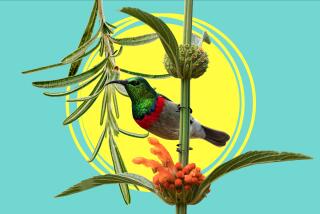Hummingbird Feeders : Perennial Penstemon, Commonly Called Beard Tongue, Serves Its Colorful Buffet of Blooms Much of the Year
- Share via
If you like the look of snapdragons but want something that lasts more than one season, try penstemon. These perennials grow into small shrubs that blossom much of the year, are rust-resistant and attract hummingbirds.
Penstemon come in a variety of colors, including red, pink, salmon, peach, deep rose, lilac, white, violet and lavender. They can be found at the nursery now and do well when planted in February.
There are many types of penstemon, commonly called beard tongue, most of which are native to the western U.S., Canada and Mexico. The variety found in most nurseries is border or garden penstemon (Penstemon gloxinioides). Other varieties are generally grown by specialty growers.
Penstemon is very adaptable and can grow in just about any climate, including the desert and mountains, says Jim Kitano, manager of Kitano’s Garden Center in La Palma.
“You don’t see penstemon around a lot, but I think that’s changing; they’re becoming more popular,” says Kitano, who has penstemon growing in front of the store. “Penstemon don’t have to be replaced every year, and they grow really well in the heat of summer.”
Many people plant penstemon as annuals, but they will grow in the garden for years and continue to spread, says Kitano.
Penstemon come in six-packs, four-inch pots and gallon cans and can be grown by seed. For healthy penstemon plants, consider the following tips:
* Find a sunny area in the garden where the penstemon has room to spread. The first year it will grow two or three feet high. By the second year it will spread to two feet across.
* Don’t plant in heavy clay soil where it would be subject to root rot. If soil has a lot of clay, amend with redwood compost in the amount of three cubic feet per 50 square feet.
* Add a starter fertilizer high in phosphorus and potassium when planting. These minerals initiate strong root and stem growth, which are critical for a healthy plant. Once the plant puts on new growth, it has become established. At that time begin fertilizing with a mixture high in nitrogen to encourage lush foliage.
* Water daily until established unless there is rain and weekly thereafter. Water twice a week when the weather is hot.
* Start seed in a planting tray or pots and transplant in the garden when the plant has become root bound. This occurs when the roots start coming out of the bottom of the pot or when you tap the container lightly and remove the plant and the soil is encircled by roots.
* If planting in containers, use a pot no smaller than six inches. Within a year you will probably have to move the plant to an 18-inch pot. Surround the base of the plant with small, draping flowers such as alyssum or lobelia.
* Deadhead on a regular basis to get blossoms more quickly. Cut off each dead flower stalk at the base of the plant.
* Keep an eye out for holes in leaves, as insects such as grasshoppers and caterpillars love penstemon.






